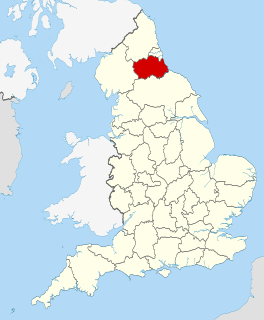
County Durham, officially simply Durham, is a ceremonial county in North East England. The ceremonial county spawned from the historic County Palatine of Durham in 1853. In 1996, the county gained part of the abolished ceremonial county of Cleveland. The county town is the city of Durham. The county borders Cumbria to the west, North Yorkshire to the south, and Tyne and Wear & Northumberland to the north. Boundaries initially aligned to the historic county, stretching between the rivers Tyne and Tees. The County Borough of Teesside formed in 1968, the ceremonial boundaries adjusted while the historic boundaries remained. The Local Government Act 1972 in 1974 further separated the boundaries. The largest settlement is Darlington (92,363) followed by Hartlepool (88,855) and Stockton-on-Tees (82,729).

Sedgefield is a constituency in County Durham represented in the House of Commons of the UK Parliament since 2019 by Paul Howell of the Conservative Party. It elects one Member of Parliament (MP) by the first past the post system of election.
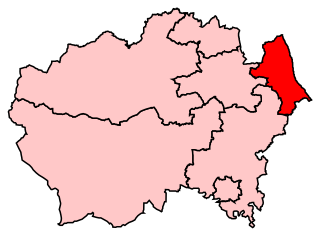
Easington is a constituency created in 1950 represented in the House of Commons of the UK Parliament since 2010 by Grahame Morris of the Labour Party.
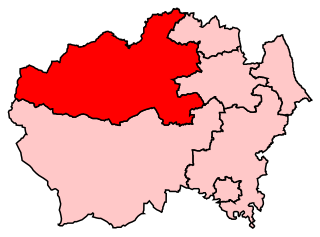
North West Durham is a constituency represented in the House of Commons of the UK Parliament since 12 December 2019 by Richard Holden of the Conservative Party.
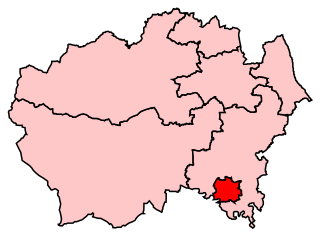
Darlington is the parliamentary constituency for the market town of the same name in County Durham in the North East of England. It is currently represented in the House of Commons of the UK Parliament by Peter Gibson of the Conservative Party, who was first elected in 2019.

Bishop Auckland is a constituency represented in the House of Commons of the UK Parliament since 2019 by Dehenna Davison, a Conservative.

Stockton-on-Tees is a former borough constituency represented in the House of Commons of the Parliament of the United Kingdom. It elected one Member of Parliament (MP) by the first past the post system of election from 1868 to 1983.

Houghton-le-Spring was a county constituency of the House of Commons of the Parliament of the United Kingdom from 1885 to 1983. Centred on the town of Houghton-le-Spring, now part of the City of Sunderland, it elected one Member of Parliament (MP) by the first-past-the-post system of election.
Barnard Castle was a county constituency centred on the town of Barnard Castle in County Durham, which returned one Member of Parliament (MP) to the House of Commons of the Parliament of the United Kingdom. It was created for the 1885 general election and abolished for the 1950 general election.

Balham and Tooting was a constituency in South London, which returned one Member of Parliament (MP) to the House of Commons of the Parliament of the United Kingdom. It was created for the 1918 general election and abolished for the 1950 general election.

Salford South was a parliamentary constituency in the City of Salford in Greater Manchester from 1885 until 1950. It returned one Member of Parliament (MP) to the House of Commons of the Parliament of the United Kingdom.
The Hartlepools was a borough constituency represented in the House of Commons of the UK Parliament. The constituency became Hartlepool in 1974. The seat's name reflected the representation of both old Hartlepool and West Hartlepool.

Chester-le-Street was a county constituency centred on the town of Chester-le-Street in County Durham. It returned one Member of Parliament (MP) to the House of Commons of the Parliament of the United Kingdom from 1885 to 1983.

South East Essex was a parliamentary constituency in Essex in the East of England. It returned one Member of Parliament (MP) to the House of Commons of the Parliament of the United Kingdom.
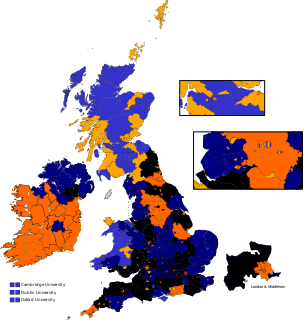
South Durham, formally the Southern Division of Durham and often referred to as Durham Southern, was a county constituency of the House of Commons of the Parliament of the United Kingdom. It elected two Members of Parliament (MPs) by the bloc vote system of election.
Mid Durham was a county constituency represented in the House of Commons of the Parliament of the United Kingdom. It elected one Member of Parliament (MP) by the first past the post system of election from 1885 to 1918.

Durham County Council is a local authority administering all significant local government functions in the unitary authority area of County Durham in North East England. The council area covers part of the ceremonial county of County Durham, excluding those parts which now form part of the Borough of Darlington, Borough of Hartlepool and the part of Borough of Stockton-on-Tees north of the River Tees.

County Durham is a unitary authority in the ceremonial county of Durham, North East England. It covers the former non-metropolitan county and its seven districts: Durham (city), Easington, Sedgefield (borough), Teesdale, Wear Valley, Derwentside, and Chester-le-Street. It is governed by Durham County Council and has 136 civil parishes.
The county of Durham has returned 7 MPs to the UK Parliament since 1983. Under the Local Government Act 1972, which came into effect on 1 April 1974, the boundaries of the historic/administrative county were significantly altered with the north-east of the county, comprising more than half the electorate, being transferred to the new metropolitan county of Tyne and Wear. In addition, the borough of Hartlepool was included in the new county of Cleveland. These changes were reflected in the following redistribution of parliamentary seats which did not come into effect until the 1983 general election, resulting in a reduction in the county's representation from 16 to 7 MPs.
















